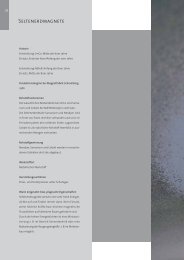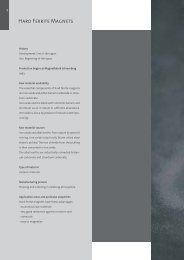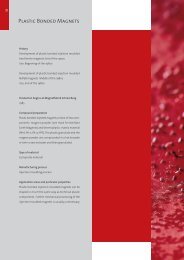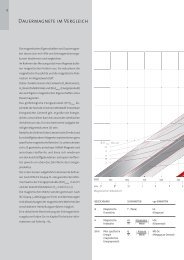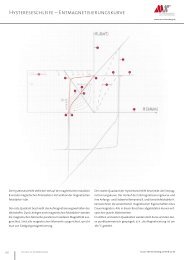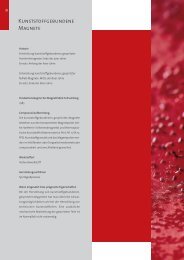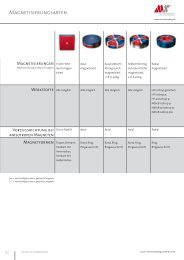Rare Earth Magnets
Rare Earth Magnets
Rare Earth Magnets
You also want an ePaper? Increase the reach of your titles
YUMPU automatically turns print PDFs into web optimized ePapers that Google loves.
18<br />
<strong>Rare</strong> <strong>Earth</strong> <strong>Magnets</strong><br />
History<br />
Development SmCo: Middle of the 1960s<br />
Use: End of the 1960s/beginning of the 1970s<br />
Development NdFeB: Beginning of the 1980s<br />
Use: Middle of the 1980s<br />
Production begins at Magnetfabrik Schramberg<br />
1986<br />
Raw material availability<br />
The essential constituents of SmCo are samarium<br />
und cobalt; those of NdFeB are neodymium and iron.<br />
Samarium and neodymium occur abundantly as<br />
ores. They are classified as rare earth metals in the<br />
periodic table of elements. Cobalt also occurs in sufficient<br />
abundance as a natural raw material.<br />
Raw material sources<br />
Neodymium, samarium and cobalt are mined in various<br />
countries around the globe.<br />
Type of material<br />
Metallic<br />
Manufacturing process<br />
Pressing and sintering in inert gas<br />
Application areas and particular properties<br />
<strong>Rare</strong> earth magnets exhibit very high energy density.<br />
They are indicated wherever maximum force and<br />
magnetic flux density are required in small spaces.<br />
Their high energy density makes it possible to use<br />
miniature magnets, for example in sensor technology,<br />
and more compact modules, for example in<br />
motor engineering.
20 <strong>Rare</strong> earth magnets<br />
The Path from Raw<br />
Material to Magnet<br />
Alloying<br />
Outgoing goods inspection<br />
Magnetising, marking, coating<br />
to customer specifications<br />
<strong>Rare</strong> earth magnets consist mainly of intermetallic<br />
compounds of rare earth metals (samarium,<br />
neodymium) and transition metals (such as cobalt,<br />
iron). In contrast to hard ferrite magnets, milling,<br />
pressing, and sintering is carried out in an inert gas<br />
atmosphere. The magnets are pressed either in an<br />
oil bath (isostatically) or in a die (axially or diametrically).<br />
After sintering they may be further processed,<br />
for example by grinding with diamond discs.<br />
Surface finishing<br />
(grinding/sawing)<br />
Sintering
<strong>Rare</strong> earth magnets 21<br />
Inspection of incoming raw material<br />
Breaking up/sifting<br />
Milling<br />
Mixing<br />
Isostatic pressing<br />
Axial and transverse field pressing<br />
with magnetic field
22 <strong>Rare</strong> earth magnets<br />
Magnetic Ratings Compared<br />
1400<br />
1300<br />
NdFeB 300/125 h<br />
NdFeB 270/125 h<br />
NdFeB 250/125 w<br />
NdFeB 250/175 h<br />
Remanence B r<br />
[mT] (mean values)<br />
1200<br />
1100<br />
1000<br />
NdFeB 230/175 w<br />
Sm2Co17 195/160 h<br />
Sm2Co17 180/160 w<br />
NdFeB 230/220 h<br />
NdFeB 210/220 h<br />
NdFeB 200/220 w<br />
NdFeB 180/220 w<br />
NdFeB 210/250 h<br />
NdFeB 180/250 w<br />
SmCo5 160/175 h<br />
900<br />
SmCo5 140/175 w<br />
800<br />
1300 1400 1500 1600 1700 1800 1900 2000 2100 2200 2300 2400 2500 2600 2700 2800 2900 3000 3100 3200 3300 3400<br />
Coercivity H cJ<br />
[kA/m] (mean values)<br />
Forming techniques<br />
Ring, disc, segment, and rectangular magnets are the most common<br />
shapes for permanent magnets produced by pressing techniques.<br />
More unusual shapes can also be produced. It is better to press the<br />
magnets into the desired shapes, since subsequent shape changes<br />
(adding drill holes, chamfers, notches, indentations, and similar) are<br />
labour-intensive and require diamond tools. Note that these shape<br />
features can be produced only in the pressing direction. Since for<br />
anisotropic magnets, the direction of magnetisation is the same as<br />
the pressing direction, drill holes, chamfers, notches, indentations,<br />
and similar can be produced only in the direction of magnetisation.<br />
>> Further details are found under Typical Magnet Shapes in the technical information<br />
on page 60.<br />
Mechanical properties<br />
As typical sintered metals, rare earth magnets are brittle under impact<br />
and bending loads. Sm2Co17 is the most brittle. Processing such as<br />
grinding and cutting requires diamond tools because of their specific<br />
hardness. Processing with spark erosion and water jet cutting is<br />
also possible.<br />
Magnetic ratings<br />
The possible maximum operating temperatures of NdFeB magnets<br />
vary between 130 °C and 220 °C. For SmCo magnets, they are between<br />
250 °C und 350 °C. The complete magnetic ratings measured as in<br />
IEC 60404-8-5 are presented in graphs and tables on pages 24-27.<br />
Variations in shape and size may lead to deviations in these ratings.<br />
Axially, transverse field (diametrically) and isostatically pressed<br />
magnets<br />
<strong>Rare</strong> earth magnets are either cut from isostatically pressed raw magnets<br />
or pressed in a transverse field (h material) or in the axial field<br />
(w material). The different production methods affect the magnetic<br />
properties. The h materials have somewhat higher remanence (B r<br />
).<br />
The coercivity (H cJ<br />
) is identical. In general, the types pressed in an axial<br />
field fulfil user requirements and for quantity orders, they can be<br />
produced at lower cost.
<strong>Rare</strong> earth magnets 23<br />
Background information<br />
Temperature behaviour<br />
Temperature changes also affect the magnetic behaviour of rare earth<br />
magnets.The remanence and the coercivity decrease with rising temperature<br />
and increase with falling temperature (for temperature coefficients,<br />
see tables). The processes are reversible. <strong>Magnets</strong> with low<br />
operating point and/or opposing magnetic fields can, however, suffer<br />
persistent loss of magnetisation caused by reduction of<br />
coercivity at high temperatures.<br />
Chemical properties/corrosion resistance<br />
<strong>Rare</strong> earth magnets have the properties of metals; for instance, they<br />
appear shiny directly after surface processing. Acid ambient conditions<br />
will lead to the dissolution of the magnets, while they are somewhat<br />
resistant to alkaline media.<br />
SmCo5 and Sm2Co17 magnets<br />
Since they consist only of stable intermetallic phase material, at low<br />
temperatures these magnets are relatively resistant to moisture, solvents,<br />
alkaline solutions, lubricants, and neutral noxious gasses. Acids<br />
and salt solutions, in contrast, attack the magnets. Sm2Co17, as<br />
opposed to SmCo5, contains iron and can exhibit red rust. Samarium<br />
cobalt magnets are usable without protection for most applications.<br />
However, the chemical resistance can be further improved by metallic<br />
or plastic coatings.<br />
NdFeB magnets<br />
The microstructure of sintered NdFeB materials is characterised by<br />
a predominant Nd 2<br />
Fe 14<br />
B magnetic phase and an intermetallic grain<br />
boundary phase. In traditional NdFeB materials, the grain boundary<br />
phase consists of free neodymium. Like most rare earth metals,<br />
neodymium is extremely susceptible to corrosion, and spontaneously<br />
generates neodymium oxide powder or neodymium hydroxide powder,<br />
expanding in volume.<br />
In our NdFeB materials, this free neodymium is replaced as far as possible<br />
by a stable intermetallic phase (corrosion-stabilised). The corrosion<br />
susceptibility of the material is thus significantly reduced.<br />
Although the traditional, nonstabilised NdFeB materials are destroyed<br />
by pulverisation in a short time, the corrosion-stabilised NdFeB materials<br />
exhibit extraordinarily good corrosion resistance. The behaviour<br />
of the material in a humid environment can be investigated in an<br />
autoclave (see comparison of corrosion behaviour in an autoclave).<br />
Since substituting a stable intermetallic phase for the free neodymium<br />
affects the magnetic properties, it is easier to protect NdFeB materials<br />
with high coercivity from corrosion than those with high remanence.<br />
NdFeB is in principle relatively resistant to most solvents, but salts<br />
and acids are very corrosive to it. Hydrogen embrittles the material.<br />
NdFeB contains iron and can exhibit red rust. The reaction is spontaneous,<br />
gives off heat, and strongly increases the volume. The magnetic<br />
properties are lost.<br />
Corrosion-stabilised NdFeB magnets are usable without protection<br />
for many applications. Their chemical resistance can be further<br />
improved by metallic or plastic coatings.<br />
Comparison of corrosion behaviour in an autoclave<br />
In the autoclave, rare earth magnets are tested at +121 °C, 2.05 bar<br />
absolute pressure, and 100 % relative humidity.<br />
Surface loss in mg/cm 2<br />
0,01<br />
0,10<br />
1,00<br />
10,00<br />
100,00<br />
1000,00<br />
0 1 2 3 4 5 6 7 8 9 10 11 12 13 14 15 16 17 18 19<br />
Days<br />
Curve 1: Conventional NdFeB disintegrates completely within a few<br />
days.<br />
Curve 2: For corrosion stabilised NdFeB magnets, the slope of the<br />
corrosion curve stabilises after the initial, minimal surface corrosion.<br />
Further material loss is not observed. The material is passivating<br />
and in the long term exhibits a behaviour similar to Sm2Co17, which<br />
is known as a corrosion resistant material.<br />
Curve 3: Sm2Co17 shows only minimal surface corrosion in the autoclave.<br />
>> Further details are found under the heading Coatings in the technical information<br />
on page 66-67.<br />
Curve 2: Corrosion stable, high coercivity<br />
NdFeB 180/220 w – NdFeB 210/220 h<br />
Curve 1: Conventional NdFeB<br />
Curve 3: Sm2Co17 195/160 h
24 <strong>Rare</strong> earth magnets<br />
Material Data<br />
SmCo5 140/175 w<br />
SmCo5<br />
Magnetic values as in DIN IEC 60404-8-1<br />
140/175 w<br />
anisotropic<br />
160/175 h<br />
anisotropic<br />
-40 °C<br />
20 °C<br />
Energy product<br />
(B·H) max.<br />
typ. kJ/m 3<br />
min. kJ/m 3<br />
155 170<br />
140 160<br />
100 °C 200 °C<br />
Remanence<br />
B r<br />
typ.<br />
min.<br />
mT<br />
mT<br />
880 925<br />
850 900<br />
revers. Temp.<br />
coeff. of B r<br />
approx. 1)<br />
%/K<br />
-0.042 -0.042<br />
H cB typ.<br />
kA/m<br />
690 710<br />
Coercivity<br />
H c<br />
H cB min.<br />
H cJ typ.<br />
kA/m<br />
kA/m<br />
640 680<br />
2000 2000<br />
SmCo5 160/175 h<br />
H cJ min.<br />
kA/m<br />
1750 1750<br />
revers. Temp.<br />
coeff. of H cJ<br />
relative permanent<br />
permeability<br />
µ rec.<br />
Curie<br />
temperature<br />
approx. %/K<br />
approx.<br />
approx. °C<br />
-0.25 -0.25<br />
1.03 1.03<br />
720 720<br />
-40 °C<br />
20 °C<br />
100 °C 200 °C<br />
max. operating<br />
temperature<br />
approx. °C<br />
250 250<br />
Magnetising field<br />
strength<br />
min.<br />
kA/m<br />
>3000 >3000<br />
Density<br />
approx. g/cm 3<br />
8.3 8.3<br />
Vickers<br />
hardness<br />
Elasticity<br />
modulus<br />
Compressive<br />
strength<br />
Flexural<br />
strength<br />
Expansion<br />
coefficient<br />
spec. elec.<br />
resistance<br />
spec.<br />
heat capacity<br />
Thermal<br />
conductivity<br />
HV<br />
approx. 10 3 N/mm 2<br />
approx. N/mm 2<br />
approx. N/mm 2<br />
p.p.d. 2)<br />
i.p.d. 3)<br />
approx.<br />
approx.<br />
approx.<br />
approx.<br />
10 -6 /K<br />
10 -6 Ωm<br />
J/(kg·K)<br />
W/mK<br />
540-560 540-560<br />
100-200 100-200<br />
900 900<br />
120 120<br />
12.5<br />
7<br />
12.5<br />
7<br />
0.5 0.5<br />
370 370<br />
12 12
<strong>Rare</strong> earth magnets 25<br />
Material Data<br />
Sm2Co17 180/160 w<br />
-40 °C<br />
180/160 w<br />
anisotropic<br />
195/160 h<br />
anisotropic<br />
Sm2Co17<br />
20 °C 100 °C 200 °C<br />
200 220<br />
Magnetic values as in DIN IEC 60404-8-1<br />
kJ/m 3 typ.<br />
Energy product<br />
180 195<br />
kJ/m 3<br />
min.<br />
(B·H) max.<br />
1040 1100<br />
mT<br />
typ.<br />
Remanence<br />
980 1040<br />
mT<br />
min.<br />
B r<br />
-0.032 -0.032<br />
%/K approx. 1)<br />
revers. Temp.<br />
coeff. of B r<br />
750 800<br />
kA/m<br />
H cB typ.<br />
Sm2Co17 195/160 h<br />
700 720<br />
kA/m<br />
H cB min.<br />
Coercivity<br />
1800 1800<br />
kA/m<br />
H cJ typ.<br />
H c<br />
1600 1600<br />
kA/m<br />
H cJ min.<br />
-40 °C<br />
20 °C<br />
100 °C<br />
-0.19 -0.19<br />
1.04 1.04<br />
%/K<br />
approx.<br />
approx.<br />
revers. Temp.<br />
coeff. of H cJ<br />
relative permanent<br />
permeability<br />
µ rec.<br />
200 °C<br />
800 800<br />
350 350<br />
°C approx.<br />
°C approx.<br />
Curie<br />
temperature<br />
max. operating<br />
temperature<br />
4300 4300<br />
kA/m<br />
min.<br />
Magnetising field<br />
strength<br />
8.3 8.3<br />
g/cm 3<br />
approx.<br />
Density<br />
600 600<br />
HV<br />
Vickers<br />
hardness<br />
150 150<br />
10 3 N/mm 2 approx.<br />
Elasticity<br />
modulus<br />
800 800<br />
N/mm 2<br />
approx.<br />
Compressive<br />
strength<br />
150 150<br />
N/mm 2<br />
approx.<br />
Flexural<br />
strength<br />
11<br />
8<br />
11<br />
8<br />
0.75-0.9 0.75-0.9<br />
340 340<br />
10-13 10-13<br />
approx.<br />
10 -6 /K<br />
p.p.d. 2)<br />
i.p.d. 3)<br />
10 -6 Ωm approx.<br />
J/(kg·K)<br />
W/mK<br />
approx.<br />
approx.<br />
Expansion<br />
coefficient<br />
spec. elec.<br />
resistance<br />
spec.<br />
heat capacity<br />
Thermal<br />
conductivity<br />
1) In the temperature range from 20° C to 200° C<br />
2) p.p.d = perpendicular to preferred direction<br />
3) i.p.d = in preferred direction<br />
Download >> www.magnete.de
26 <strong>Rare</strong> earth magnets<br />
Material Data<br />
180/250 w<br />
anisotropic<br />
180/220 w<br />
anisotropic<br />
200/220 w<br />
anisotropic<br />
180/250 NdFeB 180/250 w w<br />
NdFeB *<br />
Magnetic values as in DIN IEC 60404-8-1<br />
Energy product<br />
(B·H) max.<br />
typ. kJ/m 3<br />
min. kJ/m 3<br />
20 °C<br />
150 °C<br />
20 °C<br />
150 °C<br />
20 °C<br />
150 °C<br />
210 160 210 155 230 180<br />
180 130 180 130 200 150<br />
-40 °C<br />
20 °C<br />
100 °C<br />
150 °C<br />
200 °C<br />
Remanence<br />
B r<br />
typ.<br />
min.<br />
mT<br />
mT<br />
1050 920 1040 920 1110 970<br />
1000 880 980 860 1050 940<br />
revers. Temp.<br />
coeff. of B r<br />
approx. 1)<br />
%/K<br />
-0.08 -0.08 -0.08<br />
H cB typ.<br />
kA/m<br />
790 680 790 680 850 740<br />
Coercivity<br />
H c<br />
H cB min.<br />
H cJ typ.<br />
kA/m<br />
kA/m<br />
720 610 720 600 790 680<br />
2800 1300 2500 900 2500 1000<br />
180/220 NdFeB 180/220 w w<br />
H cJ min.<br />
kA/m<br />
2500 1050 2200 770 2200 800<br />
revers. Temp.<br />
coeff. of H cJ<br />
relative permanent<br />
permeability<br />
µ rec.<br />
approx. 2)<br />
approx.<br />
%/K<br />
-0.5 -0.5 -0.5<br />
1.1 1.1 1.1<br />
-40 °C<br />
20 °C<br />
100 °C<br />
150 °C<br />
200 °C<br />
Curie<br />
temperature<br />
max. operating<br />
temperature<br />
Magnetising field<br />
strength<br />
approx. °C 350 350 350<br />
approx. °C 220 190 190<br />
min. kA/m ~2000 ~2000 ~2000<br />
Density<br />
approx. g/cm 3<br />
7.6 7.6 7.6<br />
Vickers<br />
hardness<br />
HV 560-580 560-580 560-580<br />
Elasticity<br />
modulus<br />
Compressive<br />
strength<br />
approx. 10 3 N/mm 2<br />
approx. N/mm 2<br />
150 150 150<br />
1000 1000 1000<br />
200/220 NdFeB 200/220 w w<br />
Flexural<br />
strength<br />
approx. N/mm 2<br />
250 250 250<br />
Expansion<br />
coefficient<br />
p.p.d. 3)<br />
i.p.d. 4)<br />
approx.<br />
10 -6 /K<br />
-1<br />
5<br />
-1<br />
5<br />
-1<br />
5<br />
-40 °C<br />
spec. elec.<br />
resistance<br />
spec.<br />
heat capacity<br />
Thermal<br />
conductivity<br />
approx.<br />
approx.<br />
approx.<br />
10 -6 Ωm<br />
J/(kg·K)<br />
W/mK<br />
1.6 1.6 1.6<br />
440 440 440<br />
8 8 8<br />
20 °C<br />
100 °C<br />
150 °C<br />
200 °C
<strong>Rare</strong> earth magnets 27<br />
Material Data<br />
NdFeB 210/250 h<br />
210/250 h<br />
anisotropic<br />
210/220 h<br />
anisotropic<br />
-40 °C<br />
20 °C<br />
100 °C<br />
150 °C 200 °C<br />
20 °C<br />
230/220 h<br />
anisotropic<br />
150 °C<br />
20 °C<br />
150 °C<br />
20 °C<br />
150 °C<br />
NdFeB *<br />
Magnetic values as in DIN IEC 60404-8-1<br />
240 190 240 190 255 200<br />
kJ/m 3<br />
typ.<br />
Energy product<br />
210 160 210 160 230 175<br />
kJ/m 3<br />
min.<br />
(B·H) max.<br />
1110 980 1115 980 1160 1020<br />
mT<br />
typ.<br />
Remanence<br />
1050 940 1050 940 1100 970<br />
mT<br />
min.<br />
B r<br />
-0.08 -0.08 -0.08<br />
%/K approx. 1)<br />
revers. Temp.<br />
coeff. of B r<br />
860 750 860 750 890 780<br />
kA/m<br />
H cB typ.<br />
NdFeB 210/220 h<br />
800 690 800 690 840 730<br />
kA/m<br />
H cB min.<br />
Coercivity<br />
2800 1300 2500 900 2500 1000<br />
kA/m<br />
H cJ typ.<br />
H c<br />
-40 °C<br />
2500 1050 2200 770 2200 800<br />
kA/m<br />
H cJ min.<br />
20 °C<br />
100 °C<br />
150 °C<br />
200 °C<br />
-0.5 -0.5 -0.5<br />
1.1 1.1 1.1<br />
350 350 350<br />
%/K approx. 2)<br />
approx.<br />
°C approx.<br />
revers. Temp.<br />
coeff. of H cJ<br />
relative permanent<br />
permeability<br />
µ rec.<br />
Curie<br />
temperature<br />
220 190 190<br />
°C approx.<br />
max. operating<br />
temperature<br />
~2000 ~2000 ~2000<br />
kA/m<br />
min.<br />
Magnetising field<br />
strength<br />
7.6 7.6 7.6<br />
g/cm 3<br />
approx.<br />
Density<br />
560-580 560-580 560-580<br />
HV<br />
Vickers<br />
hardness<br />
150 150 150<br />
10 3 N/mm 2 approx.<br />
Elasticity<br />
modulus<br />
NdFeB 230/220 h<br />
1000 1000 1000<br />
N/mm 2<br />
approx.<br />
Compressive<br />
strength<br />
250 250 250<br />
N/mm 2<br />
approx.<br />
Flexural<br />
strength<br />
-40 °C<br />
20 °C<br />
-1<br />
5<br />
-1<br />
5<br />
-1<br />
5<br />
approx.<br />
10 -6 /K<br />
p.p.d. 3)<br />
i.p.d. 4)<br />
Expansion<br />
coefficient<br />
100 °C<br />
150 °C<br />
200 °C<br />
1.6 1.6 1.6<br />
440 440 440<br />
8 8 8<br />
10 -6 Ωm approx.<br />
J/(kg·K)<br />
W/mK<br />
approx.<br />
approx.<br />
spec. elec.<br />
resistance<br />
spec.<br />
heat capacity<br />
Thermal<br />
conductivity<br />
1) In the temperature range from 20° C to 100° C<br />
2) At higher temperatures, the temperature coefficient has smaller values<br />
3) p.p.d = perpendicular to preferred direction<br />
4) i.p.d = in preferred direction<br />
*Licenced from NEOMAX Co. Ltd.<br />
Download >> www.magnete.de
28 <strong>Rare</strong> earth magnets<br />
Material Data<br />
230/175 w<br />
anisotropic<br />
250/125 w<br />
anisotropic<br />
230/175 NdFeB 230/175 w w<br />
-40 °C<br />
NdFeB *<br />
Magnetic values as in DIN IEC 60404-8-1<br />
Energy product<br />
(B·H) max.<br />
typ. kJ/m 3<br />
min. kJ/m 3<br />
20 °C<br />
150 °C<br />
20 °C<br />
100 °C<br />
260 190 280 220<br />
230 165 250 190<br />
20 °C<br />
100 °C<br />
150 °C<br />
Remanence<br />
B r<br />
typ.<br />
min.<br />
mT<br />
mT<br />
1190 1020 1230 1100<br />
1130 970 1170 1060<br />
revers. Temp.<br />
coeff. of B r<br />
approx. 1)<br />
%/K<br />
-0.09 -0.10<br />
H cB typ.<br />
kA/m<br />
890 620 890 750<br />
Coercivity<br />
H c<br />
H cB min.<br />
H cJ typ.<br />
kA/m<br />
kA/m<br />
840 480 840 650<br />
1900 650 1400 800<br />
250/125 NdFeB 250/125 w w<br />
revers. Temp.<br />
coeff. of H cJ<br />
relative permanent<br />
permeability<br />
µ rec.<br />
H cJ min.<br />
approx. 2)<br />
approx.<br />
kA/m<br />
%/K<br />
1750 500 1250 700<br />
-0.6 -0.6<br />
1.1 1.1<br />
-40 °C<br />
20 °C<br />
100 °C<br />
Curie<br />
temperature<br />
approx. °C<br />
340 330<br />
max. operating<br />
temperature<br />
approx. °C<br />
160 130<br />
Magnetising field<br />
strength<br />
min.<br />
kA/m<br />
~2400 ~2400<br />
Density<br />
approx. g/cm 3<br />
7.6 7.5<br />
Vickers<br />
hardness<br />
Elasticity<br />
modulus<br />
Compressive<br />
strength<br />
Flexural<br />
strength<br />
Expansion<br />
coefficient<br />
spec. elec.<br />
resistance<br />
spec.<br />
heat capacity<br />
Thermal<br />
conductivity<br />
HV<br />
approx. 10 3 N/mm 2<br />
approx. N/mm 2<br />
approx. N/mm 2<br />
p.p.d. 3)<br />
i.p.d. 4)<br />
approx.<br />
approx.<br />
approx.<br />
approx.<br />
10 -6 /K<br />
10 -6 Ωm<br />
J/(kg·K)<br />
W/mK<br />
560-580 560-580<br />
150 150<br />
1000 1000<br />
250 250<br />
-1<br />
5<br />
-1<br />
5<br />
1.6 1.6<br />
440 440<br />
8 8
<strong>Rare</strong> earth magnets 29<br />
Material Data<br />
NdFeB 250/175 h<br />
-40 °C<br />
20 °C<br />
250/175 h<br />
anisotropic<br />
270/125 h<br />
anisotropic<br />
300/125 h<br />
anisotropic<br />
100 °C<br />
150 °C<br />
20 °C<br />
150 °C<br />
20 °C<br />
100 °C<br />
20 °C<br />
100 °C<br />
NdFeB *<br />
Magnetic values as in DIN IEC 60404-8-1<br />
295 200 300 230 330 260<br />
kJ/m 3<br />
typ.<br />
Energy product<br />
250 175 270 200 300 240<br />
kJ/m 3<br />
min.<br />
(B·H) max.<br />
1240 1050 1280 1150 1320 1185<br />
mT<br />
typ.<br />
Remanence<br />
1180 1000 1220 1110 1260 1160<br />
mT<br />
min.<br />
B r<br />
-0.09 -0.10 -0.10<br />
%/K approx. 1)<br />
revers. Temp.<br />
coeff. of B r<br />
920 620 920 700 950 650<br />
kA/m<br />
H cB typ.<br />
NdFeB 270/125 h<br />
860 480 870 600 900 540<br />
kA/m<br />
H cB min.<br />
Coercivity<br />
1900 650 1400 780 1400 700<br />
kA/m<br />
H cJ typ.<br />
H c<br />
-40 °C<br />
20 °C<br />
100 °C<br />
1750 500 1250 680 1250 550<br />
-0.6 -0.6 -0.6<br />
1.1 1.1 1.1<br />
kA/m H cJ min.<br />
%/K approx. 2)<br />
approx.<br />
revers. Temp.<br />
coeff. of H cJ<br />
relative permanent<br />
permeability<br />
µ rec.<br />
340 330 330<br />
°C approx.<br />
Curie<br />
temperature<br />
160 130 130<br />
°C approx.<br />
max. operating<br />
temperature<br />
~2400 ~2400 ~2400<br />
kA/m<br />
min.<br />
Magnetising field<br />
strength<br />
7.6 7.5 7.5<br />
g/cm 3<br />
approx.<br />
Density<br />
560-580 560-580 560-580<br />
HV<br />
Vickers<br />
hardness<br />
150 150 150<br />
10 3 N/mm 2 approx.<br />
Elasticity<br />
modulus<br />
NdFeB 300/125 h<br />
1000 1000 1000<br />
N/mm 2<br />
approx.<br />
Compressive<br />
strength<br />
-40 °C<br />
20 °C<br />
100 °C<br />
250 250 250<br />
-1<br />
5<br />
-1<br />
5<br />
-1<br />
5<br />
N/mm 2<br />
approx.<br />
10 -6 /K<br />
approx.<br />
p.p.d. 3)<br />
i.p.d. 4)<br />
Flexural<br />
strength<br />
Expansion<br />
coefficient<br />
1.6 1.6 1.6<br />
10 -6 Ωm approx.<br />
spec. elec.<br />
resistance<br />
440 440 440<br />
J/(kg·K)<br />
approx.<br />
spec.<br />
heat capacity<br />
8 8 8<br />
W/mK<br />
approx.<br />
Thermal<br />
conductivity<br />
1) In the temperature range from 20 °C to 100 °C<br />
2) At higher temperatures, the temperature coefficient has smaller values<br />
3) p.p.d = perpendicular to preferred direction<br />
4) i.p.d = in preferred direction<br />
*Licenced from NEOMAX Co. Ltd.<br />
Download >> www.magnete.de



